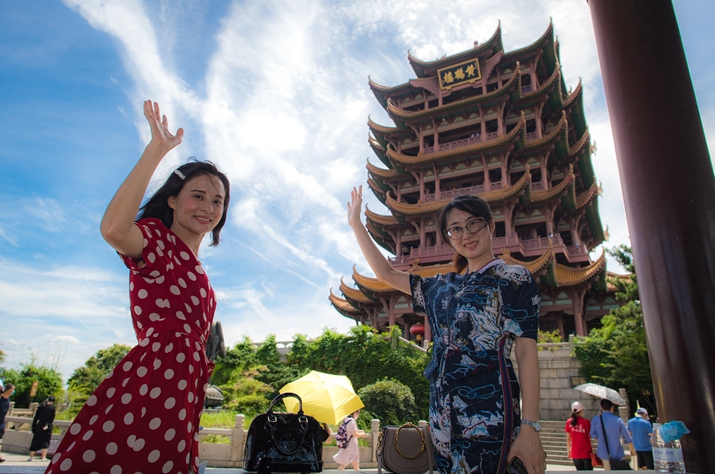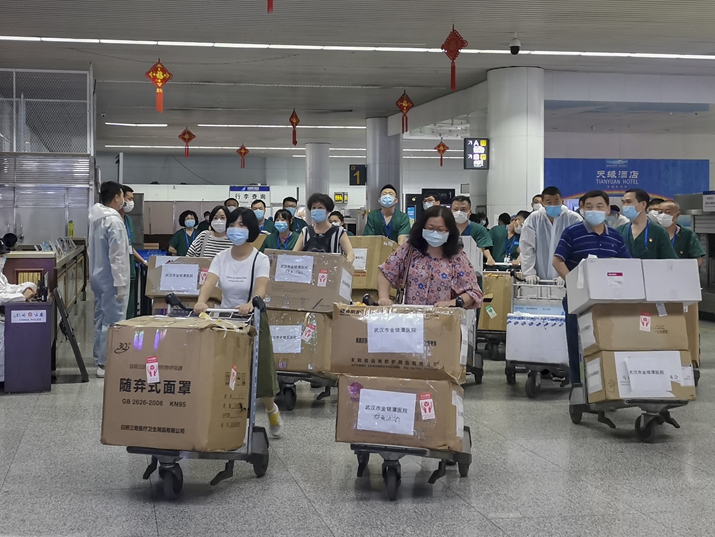|
||||||||||
| Home Nation World Business Opinion Lifestyle ChinAfrica Multimedia Columnists Documents Special Reports |
|
||||||||||
| Home Nation World Business Opinion Lifestyle ChinAfrica Multimedia Columnists Documents Special Reports |
| ChinAfrica |
| Hubei people return the favors as the province recovers from the coronavirus epidemic |
| Hubei Province in central China is recovering from virus-induced impacts |
| By Hu Fan VOL.12 September ·2020-09-08 |

Two health professionals from Hainan Province visit Huanghelou in Wuhan on the invitation of the Hubei Province on August 7. They were part of the medical aid team members sent to Hubei in the first half of this year (XINHUA)
On August 6, Wu Lei, a nurse at the Jiangsu Cancer Hospital in Nanjing, Jiangsu Province in east China, was reminded of the days he fought the COVID-19 epidemic with his colleagues in Huangshi, a city in the hardest-hit central province of Hubei. Early in the morning, he received a package of fresh grapes as a thank-you gift from Huangshi. "I am glad people there still remember us," he said.
Wu was one of the 310 members of a medical team sent by Jiangsu to Huangshi on February 11. On that day, the number of COVID-19 cases in the city reached 874. The team members were assigned to five different hospitals and Wu was responsible for the allocation of supplies.
The grapes were sent by a rural cooperative. Villagers and volunteers picked 1,300 kg of the fruit the day before and shipped it to Jiangsu in packages. Wang Youwen, President of the cooperative, said it was a way to thank the medical workers from Jiangsu for their assistance. With their help, the epidemic in Huangshi was brought under control in mid-March and the cooperative was able to resume operation. "People here are very grateful to them," he said.
Starting in January, over 42,000 doctors and nurses from across the country came to Hubei to join the fight against the epidemic. Thanks to their help and other external support, the province was able to quickly curb the disease. On April 26, the last COVID-19 patient in Hubei was discharged from the hospital in the provincial capital city of Wuhan. Since then, Hubei people have been looking at ways to return the kindness they received.
Medical aid
On July 18, a plane carrying a team of medical workers from Wuhan landed at Urumqi, capital of Xinjiang Uygur Autonomous Region in northwest China. The team was composed of 21 doctors and nurses from three hospitals, who also brought with them over 100 COVID-19 testing instruments and other medical supplies.
Ren Yi, a member from the Wuhan Pulmonary Hospital, said the team was formed and departed from Wuhan within 36 hours after they were informed of the plan to aid Urumqi, which made them the first of the 10 aid teams from different provinces to arrive in the region that was seeing a resurgence of COVID-19 cases.
"We share the belief that it is time for us to pay our debt of gratitude," he told Health Times. Xinjiang sent its first medical team comprised of 142 members to Hubei on January 28, followed by another two groups.
Ren's team helped a local hospital remarkably improve its capacity of nucleic acid tests with the equipment they brought and their experience in conducting such tests in Wuhan. They also shared their knowledge of self-protection, so that health workers wouldn't suffer from hand inflammation.
A week before the departure of the Xinjiang-bound medical workers, another Wuhan medical team had just returned home from their mission in Beijing. The team comprised 70 members from six hospitals and worked for 21 days in the capital city. They were dispatched to help increase the testing capacity, a key factor in Beijing's success in controlling the virus.
Though the epidemic in both Beijing and Xinjiang was relatively less severe and local hospitals were far from being overwhelmed, having more health workers to conduct tests was helpful in screening as many people as possible. Wuhan's medical teams also shared their expertise in testing. On June 1, the city finished a city-wide campaign in which more than 10 million people were tested in a span of 19 days.
Apart from medical aid, Hubei also sent agricultural supplies to Beijing. On June 21, 352 tons of local produce from different parts of the province, including crayfish, sweet oranges and processed eggs, were shipped to the capital city.

A medical aid team from Wuhan, Hubei Province, arrives in Urumqi, Xinjiang Uygur Autonomous Region, on July 18 (XINHUA)
Accelerated recovery
On August 7, Hubei announced that it will open all of its over 400 major scenic spots free of charge to tourists from all over the country for the rest of the year. People from areas with a low risk of COVID-19 infection can enjoy this benefit.
"This is to thank people for their support during the epidemic, especially the medical personnel who came to our aid," Vice Governor Zhang Wenbing said at a press conference.
On the same day, the first batch of medical workers aiding Hubei started their tour in the province. It was part of an initiative to invite medical personnel, community workers and volunteers who contributed to the anti-epidemic battle in Hubei to visit the province's tourist attractions for free.
The move is also seen by some as a measure to increase tourist arrivals to accelerate post-epidemic economic recovery.
According to the National Bureau of Statistics, while China as a whole registered a 3.2-percent year-on-year GDP growth in the second quarter, Hubei's economy contracted 19.3 percent, although the figure represented a major rebound compared to the first quarter, when the drop was 39.2 percent.
To make the situation worse, Hubei was also hit hard by floods during the raining season. By July 21, around 14 million people across the province had been affected and 29 people died due to rainstorm-triggered disasters. The disasters caused a direct economic loss of over 24 billion yuan ($3.5 billion) and destroyed or damaged over 70,000 houses, according the province's flood control and drought relief authority.
Once again, other parts of the country lent a helping hand. Campaigns to promote Hubei's local produce were organized by various news agencies, e-commerce companies and social media platforms, and new polices were released to increase support to Hubei's recovery. On June 3, 34 stated-own enterprises signed agreements with the provincial government on 72 projects with a total investment of around 328 billion yuan ($47.3 billion).
Efforts are bearing fruit, as some sectors are reporting year-on-year growth, especially those in the secondary industry. The automobile industry, the most important pillar of the province's economy, registered a 4.5-percent growth in June. Growth has also been reported in hi-tech manufacturing, especially the production of lithium battery, computers and optic fiber, according to the Hubei Provincial Bureau of Statistics.
Wu Zhongzhi, Deputy Director of the bureau, believes the impact of the epidemic will not rock the foundation of the province's economic growth. "I am confident that Hubei's economy will soon be revitalized and return to its place among China's strongest provincial economies," he said in an interview with China Central Television. CA
| About Us | Contact Us | Advertise with Us | Subscribe |
| Copyright Beijing Review All rights reserved 京ICP备08005356号-5 京公网安备110102005860号 |